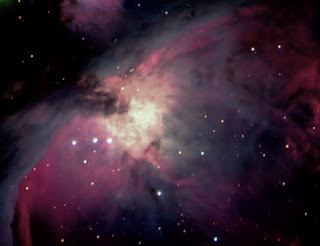Physics Photo of the Week
Physics Photo of the Week
March 22, 2024
M42 - The Great Nebula in Orion - Astrophotos by College View Observatory
The Orion Nebula - Messier 42 - is the brightest nebulous object in the sky - even visible with the naked eye in dark skies. If this looks like a large cosmic cloud lit up from the inside - that's exactly what it is! This cloud is in the Milky Way galaxy - "only" about 1300 light years distant. This nebula is relatively close. The closest external galaxy is about 2 Million light years distant - over 1000 times further away. The colors and the large angular size (greater than one degree) make the Orion Nebula one of the most beautiful and interesting cosmic objects!
The interior light for illuminating this gigantic cosmic cloud is a nursery of "baby" stars in the middle of it. However the "baby" stars are not "innocent". They are some of the hottest stars known in the cosmos as well as some of the largest.*
The photo at left is the same image, and printed at about the same scale. The video gain (contrast) has been greatly reduced such that the central bright glow is highly reduced enabling the bright, "baby" stars to show. Notice the three bright stars in a horizontal row near the central glow for the scale of the photo.
The bright young infant stars are the four tightly-spaced stars in the midst of the glowing cloud. This small cluster is called the "Trapezium" cluster due to the shape of a trapezoid. These are also extremely hot stars - about 30,000 kelvin on their surfaces (compare the Sun's surface of "only" about 5500 kelvin). Because these stars are so hot (spectral class "O" in astrophysical jargon), they radiate most of their energy in the ultraviolet (UV) part of the spectrum. The strong UV light ionizes the cloud (mostly hydrogen gas in the cloud) and causes the cloud to fluoresce (re-emit visible light as the ionized gas in the cloud re-combines with electrons). This is the same principle of operating a fluorescent light bulb. In the fluorescent lamp, the UV light is caused by electric current as electrons, striking the atoms of mercury vapor, ionizing the mercury, which then emits UV radiation. The UV from the mercury emission excites the zinc oxide coating on the inside of the fluorescent lamp to "fluoresce" or glow in visible light.
Deep within the clouds are many more "baby" stars and even stars that are just now being "born" as detected by cloud-penetrating space-based infrared imagers.
The cloud that forms the Orion Nebula is contracting under its own gravity. Eventually parts of the cloud become so dense and so hot that the pressure and temperature is enough to ignite thermonuclear fusion (H-bomb) that the new stars are formed and are self-sustaining for many years! Even though we would not want to be close to this "beastly cluster of baby stars", the resulting glow make this nebula one of the most beautiful objects to examine with telescopes!
______________
* The Trapezium stars in the Orion nebula are not as hot as so-called "white dwarfs". White dwarfs are "dead" stars that have used-up all their fuel; they have shrinked to the the size of the Earth (100 times smaller than the Sun); but are often hotter than the Trapezium stars. White dwarfs slowly cool down over several million years and become cooler celestial "cinders". The Trapezium are very young "ordinary" stars that have just "recently" begun their nuclear fusion process.
======================================================================
Physics Photo of the Week is published periodically during the academic year on Fridays by Donald F. Collins, professor emeritus of Warren Wilson College. These photos feature interesting phenomena in the world around us. Students, faculty, and others are invited to submit digital (or film) photographs for publication and explanation. Atmospheric phenomena are especially welcome. Please send any photos to dcollins@warren-wilson.edu.
All photos and discussions are copyright by Donald Collins or by the person credited for the photo and/or discussion. These photos and discussions may be used for private individual use or educational use. Any commercial use without written permission of the photoprovider is forbidden.





Comments
Post a Comment